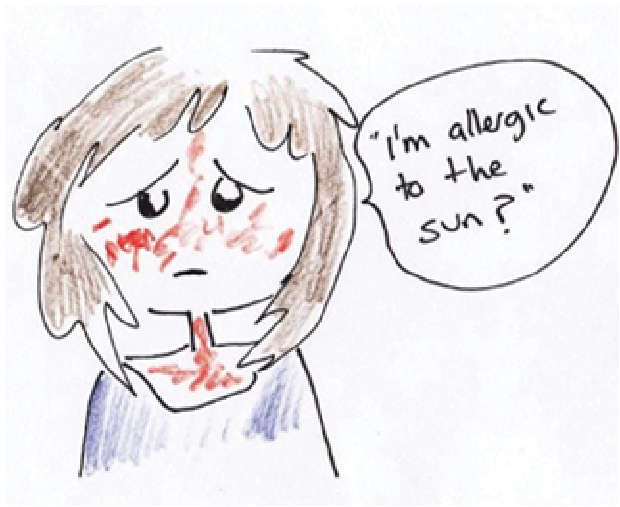1
Dr Kindy Newmai
MD (Dermatology, Venerology & Leprology), Junior Consultant
Department of Dermatology, CIHSR
BEAT THE HEAT: Sun allergy
A sun allergy is an immune system reaction to sunlight, most often, an itchy red rash. The most common locations include the "V" of the neck, the back of the hands, the outside surface of the arms and the lower legs. In rare cases, the skin reaction may be more severe, producing hives or small blisters that may even spread to skin in clothed areas.
Sun allergies are triggered by changes that occur in sun-exposed skin. It is not clear why the body develops this reaction. However, the immune system recognizes some components of the sun-altered skin as "foreign," and the body activates its immune defenses against them. This produces an allergic reaction that takes the form of a rash, tiny blisters or, rarely, some other type of skin eruption.
Sun allergies occur only in certain sensitive people, and in some cases, they can be triggered by only a few brief moments of sun exposure. Some forms of sun allergy are inherited.

One of the most common sun allergies is PMLE (Polymorphic Light Eruption)
PMLEtypically produces an itchy or burning rash within the first two hours after sun exposure. The rash usually appears on sun-exposed portions of the neck, upper chest, arms and lower legs. In addition, there may be one to two hours of chills, headache, nausea and malaise (a general sick feeling). In rare cases, PMLE may erupt as red plaques (flat, raised areas), small fluid-filled blisters or tiny areas of bleeding under the skin.

Do I have PMLE?
If you have mild symptoms of PMLE, you may be able to diagnose the problem yourself by asking yourself the following questions:
• Do I have an itchy rash that occurs only on sun-exposed skin?
• Does my rash always begin after sun exposure?
Do my symptoms first appear during the early spring, and then gradually become less severe (or disappear) within the following few days or weeks?
If you can answer "yes" to all of these questions, then you may have mild PMLE.
The rash of PMLE usually disappears within two to three days if you avoid further sun exposure. Over the course of the spring and summer, repeated sun exposure can produce hardening, a natural decrease in the skin's sensitivity to sunlight. In some individuals, hardening develops after only a few days of sun exposure, but in others it takes several weeks.
Prevention

If you are sun-sensitive, you should take extra steps to protect yourself when outside. Limit time in the sun, and wear protective clothing and a wide-brimmed hat. A broad-spectrum sunscreen is a must—but if you find that you are sensitive to one product, or if it doesn’t prevent symptoms, try another one with different ingredients. Sunscreens that contain only zinc oxide or titanium dioxide, which act as physical sun blocks, may be better tolerated than ones that contain chemical UV-absorbing ingredients, such as cinnamates. Before you go outdoors apply a sunscreen that has a sun protection factor (SPF) of at least 30 or above, with a broad spectrum of protection against both ultraviolet A and ultraviolet B rays.
Limit your time outdoors when the sun is at its peak -from about 10 a.m. to 3 p.m.
Wear sunglasses with ultraviolet light protection.
Wear long pants, a shirt with long sleeves and a hat with a wide brim.
Be aware of skin care products and medicines, especially certain antibiotics, that may trigger a photoallergic eruption. If you are taking a prescription medication, and you normally spend a great deal of time outdoors, ask your doctor whether you should take any special precautions to avoid sun exposure while you are on the drug.
Treatment
For mild symptoms, either apply cool compresses (such as a cool, damp washcloth) to the areas of itchy rash or apply calamine lotion. A nonprescription oral (by mouth) antihistamine can be given for the itch with a corticosteroid cream in moderate cases.
Some studies suggest that consuming carotenoid-rich fruits and vegetables confers some degree of photo-protection.
When to seek help?
Visit your dermatologist if you have:
• An itchy rash that does not respond to over-the-counter treatments
• A rash that involves large areas of your body, including parts that are covered by clothing
• A persistent rash that covers sun-exposed areas of your face, especially if you are a woman or have a family history.
• Abnormal bleeding under the skin in sun-exposed areas
• Call for emergency help immediately if you suddenly develop hives together with swelling around your eyes or lips, faintness or difficulty breathing or swallowing. These may be signs of a life-threatening allergic reaction.





